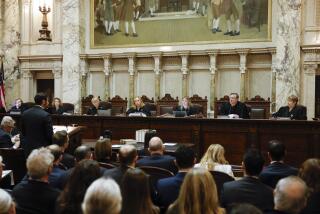Redestricting a Democratic supermajority
Redistricting reform is almost certainly dead for the rest of this decade. After all the hype that this was the year that Sacramento lawmakers would finally relinquish their power to draw the state’s congressional and legislative districts -- and hand that role over to a nonpartisan entity -- the politicians surrendered nothing.
Certainly, a change in the current system is long overdue. Thanks to the 2001 redistricting by the Legislature, not a single legislative district changed parties in the 2004 and 2006 elections, and only one congressional district did. Now, however, it looks like noncompetitive elections may be with us for a long time to come.
The Democrats were initially pushing for change. They were willing to relinquish their redistricting power for two reasons. First, there is no chance that Republicans will win a majority in either house of the Legislature in the foreseeable future because the state is so heavily Democratic. And second, reform was part of a larger deal that would include relaxing term limits; the two were bundled together as a legislative proposal with the strong backing of Gov. Arnold Schwarzenegger.
But Democratic legislative leaders came to see that the surest route to longer stays in Sacramento was not through the Legislature but the ballot box. So they wrote an initiative, which will appear on the February ballot, that will allow them an additional term in the Assembly and in the Senate. In doing so, they removed the incentive to pursue redistricting reform, which died at the end of the legislative session.
The question is whether the next scheduled redistricting in 2011 will be a compromise between Republicans and Democrats, as in 2001, or highly partisan, as in the 1980s.
The answer is pretty clear. Democrats will use their mapmaking power to try to achieve a two-thirds majority in both houses of the Legislature, thus wiping out the ability of Republicans to influence budget and tax legislation, which require a supermajority to pass. Currently, the Democrats are two seats short of that vote threshold in the Senate and six in the Assembly.
Many Democrats feel that they were too generous in 2001 when they agreed to leave all incumbent legislators in place and create 20 safe congressional districts for the GOP while, elsewhere in the country, Republicans eviscerated Democrats in states where they controlled redistricting. For instance, former House Majority Leader Tom DeLay engineered a mid-decade gerrymander in Texas that gave the GOP six new congressional districts in 2004.
So Democrats have an incentive to reduce the GOP’s presence in state and congressional politics, especially after 15 Senate Republicans held up passage of this year’s budget for nearly two months.
But can Democrats really gain two-thirds control of both chambers through a partisan gerrymander?
Yes, with a little luck. The first step would be the election of a Democratic president in 2008, who would decide how the U.S. Census Bureau conducts the decennial count in 2010-11.
In 2001, the question was whether the Census Bureau should adjust upward the count to reflect the true population in areas with high numbers of illegal immigrants because, in theory at least, these immigrants had avoided the census-takers. The Republicans, who controlled the census, refused such an adjustment in part because it would have increased the population count in Democratic voting areas.
A Democratic president is sure to order an upward census adjustment because counting more people in the central cities means that Democratic mapmakers can more easily disperse Democratic voters into other districts. Districts must be equally populated -- currently 847,000 for a Senate district and 423,000 for an Assembly one. With more population to work with, they can draw lines that move Democratic voters into suburban Republican districts, making them more Democratic and compacting the GOP districts.
So a quick tweak of political lines could erase the slim Republican voter edge in the district held by state Sen. Abel Maldonado (R-Santa Maria) and significantly boost the number of Democratic voters in the district of state Sen. Tom McClintock (R-Thousand Oaks), thus giving the Democrats the two seats they need to achieve a two-thirds majority in the Senate.
The six seats the Democrats need in the Assembly to claim a supermajority would present more of a challenge but would be far from impossible. Two GOP-held seats, one in San Diego and one in Riverside and Imperial counties, were initially drawn in 2001 to be Democratic, so a partisan gerrymander could easily return them to the Democratic fold.
Coming up with a second Democratic seat in Orange County would not be difficult, nor drawing new Democratic seats in the San Gabriel and San Fernando valleys, especially if the population in Democratic areas is adjusted upward. Democratic mapmakers would just have to project fingers of urban Democratic voters outward to eliminate or combine Republican seats in the suburbs.
Democrats controlled more than two-thirds of the Assembly from 1974 to 1978, and California was far less Democratic then. Republicans still held districts in such places as Burbank and Glendale. Carving out two-thirds of the seats for themselves in both houses of the Legislature in 2011 would be easy by comparison.
By then, Schwarzenegger will be gone, probably replaced by a Democrat. And in the long run, the Republican Party as a force in the state Capitol -- and the idea of two-party government in California -- also may be history.
Tony Quinn is co-editor of the California Target Book, a nonpartisan analysis of legislative and congressional elections.
More to Read
A cure for the common opinion
Get thought-provoking perspectives with our weekly newsletter.
You may occasionally receive promotional content from the Los Angeles Times.






